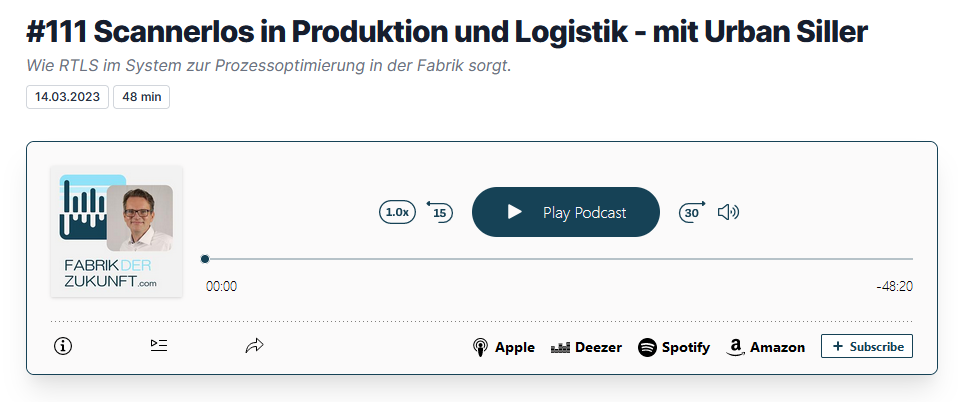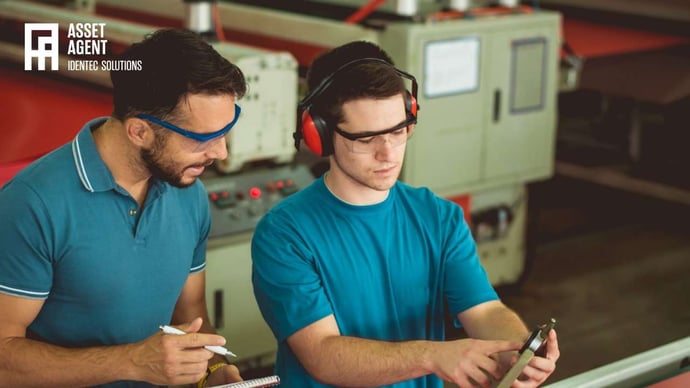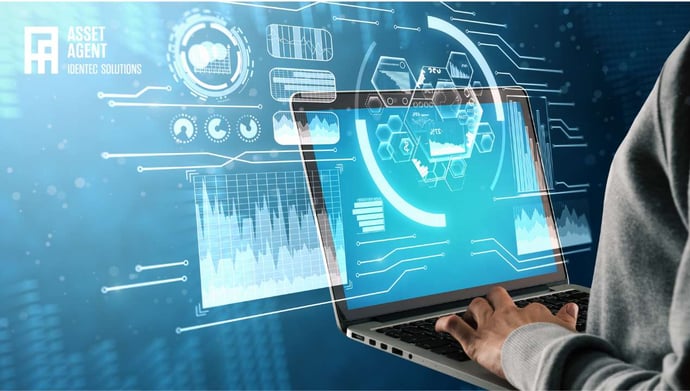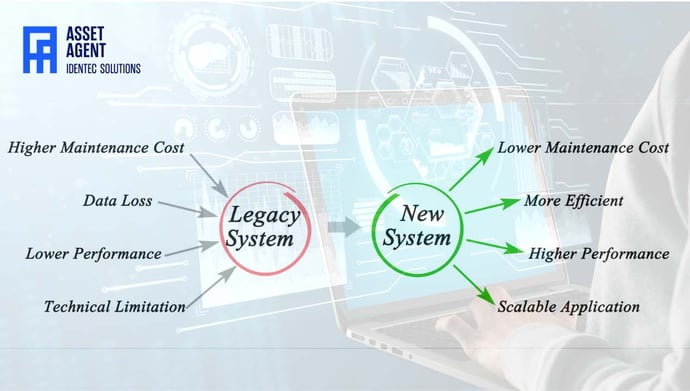Future Factory: Transforming Production With Industry 4.0
| Written by Mark Buzinkay
Welcome to the Future Factory! The fourth industrial revolution is upon us, and companies of all sizes and sectors are beginning to embrace Industry 4.0 technologies. From robotics and automation to process automation and data analytics, the aim of Industry 4.0 is to make production faster, smarter, and more efficient.
But how do you go about transforming your production with Industry 4.0? To help you get started, Urban Siller, CEO of Identec Solutions, and Tobias Herwig, host of the podcast "Fabrik der Zukunft", talked on air about the reality of Industry 4.0, the technologies that are driving it, and the steps you can take to make sure your business is ready to adopt the technologies. So, fasten your seatbelt and get ready to enter the Future Factory!

No video selected
Select a video type in the sidebar.
Future Factory: What is Industry 4.0?
Industry 4.0 is a term used to describe the current automation and data exchange trend in the manufacturing industry. It describes a transformation of traditional manufacturing and industrial practices, utilising modern technology such as intelligent robots, analytics, and Internet of Things (IoT) sensors. The aim of Industry 4.0 is to upgrade the traditional manufacturing environment to a digital production system, creating a future factory.
This technology revolutionises the way products are made, managed, and evaluated. Industry 4.0 streamlines and automates production processes, making production faster and more efficient. Additionally, the sensor technologies connected to the IoT collect and analyse data from the production environment, allowing for greater insight into production. This data can then be used to improve and optimise the production process.
The final result of Industry 4.0 is the creation of a future factory. This factory utilises the latest technology to create a flexible and efficient production system. As a result, the future factory is able to produce products quickly and efficiently while also providing a real-time view of the production process. This means that production planning and quality control can be easily and accurately managed, resulting in higher production yields while also reducing costs.
Overall, Industry 4.0 is revolutionising the way products are made. The future factory is quickly becoming a reality by utilising modern technologies such as the IoT, intelligent robots and data analytics. This new, more efficient production system is allowing businesses to stay competitive and improve their bottom line.
Interested in sustainability? Then continue reading our article about "What sustainable development goals drive the tire industry forward?"
Future Factory and Industry 4.0 Technologies
Industry 4.0 is the fourth industrial revolution, which is transforming production and manufacturing processes with the help of cutting-edge technologies. This includes using cyber-physical systems, the Internet of Things (IoT), artificial intelligence (AI), blockchain, and cloud computing, among other cutting-edge technologies. This new technology is driving an unprecedented level of efficiency and productivity in the production process, and the buzzword "Future Factory" is a term that has emerged to describe this revolution.
At its core, the Future Factory is designed to revolutionise how products are designed, produced, and delivered to customers. The idea is to use computers, sensors, and algorithms to become more efficient and flexible in production. This will require deeper integration of machines into the production process and the increased use of Automation and AI to make decisions with greater accuracy and speed.
The use of cyber-physical systems gives manufacturers the ability to quickly and efficiently monitor and control the production process. By connecting the machines in the factory to the internet, manufacturers can monitor the process in real time and make adjustments as needed. Furthermore, the use of AI and machine learning can be used to identify potential problems or inefficiencies in the production process and take corrective actions.
The Internet of Things (IoT) provides a platform for connecting machines, devices, and systems to collect data. This data can be used to improve production processes and make more accurate decisions. For example, sensor data can be used to identify when a machine needs maintenance or replace faulty parts. Furthermore, predictive analytics can be used to predict future trends and optimise production outputs.
Blockchain technology also has the potential to revolutionise the production process. By enabling the secure and decentralised storage and transfer of data, blockchain can help guarantee the integrity of each transaction throughout the supply chain. Additionally, blockchain can be used to verify the identity of contractors and suppliers, ensuring that only authorised people have access to the factory and its resources.
The use of cloud computing can also improve the efficiency of production processes. This technology can be used to store and analyse large amounts of data in order to identify patterns and trends. Additionally, cloud computing can be used to deploy applications and services quickly and securely, making it easier for a factory to scale up operations and speed up production.
Learn more about RTLS tags and factory efficiency.
Robotics and automation
Robotics and automation have become key components of Industry 4.0 and the future factory. It is estimated that there are approximately 3.4 million industrial robots in use worldwide (1). Automation of production processes is a significant element of the Industry 4.0 shift to the future factory. Automation of the factory processes can save time and money, improve production precision and reduce environmental impact. With automation, production systems can be designed to detect and correct issues in production processes quickly. This helps to reduce delays, minimise waste and increase the overall efficiency of production processes. By including robotics, the future factory can optimise production processes and increase the speed of production. Robotics can be used to automate tedious and repetitive tasks that could be dangerous for humans to complete – thus ensuring the safety of workers. Robotics can also be used to simplify and streamline the production process. This helps to reduce the cost of production and increase the overall productivity of the factory.
Future Factory: Implement Industry 4.0 at low-cost
We described the technologies and concepts of industry 4.0 in a nutshell. As this is the theory and ideal scenario, what about the reality of today's factories, such as brownfield operations?
Tobias Herwig: Paperless has been a goal in the factory for some time. But I find it exciting that barcode scanners also cause a problem. Why it became a problem?
Urban Siller: The scan of a barcode links logically the process with the physical process, so for example, you should somehow bring material to a production island, and then the expectation is that you now carry out the scan, so that, for example, your material flow system, production planning system, really knows that the material is there now and I can take the next step. So when I forget the scan because I've already done the physical job, the process goes no further. So then the machine stops, the production stops, and then I don't manage the output on the day I planned.
Tobias Herwig: Yes, that's a big problem. You just said the scanners are an attempt or a good way to link the real world with the digital world and close this gap, which in practice, is simply there. What other options exist for doing this? That is a significant point, especially with manual processes.
Urban Siller: So ideally, you find a solution to do it so that the employee does his job. For example, "Go to a location and get a certain material there." And now you can, of course, say yes, the employee should now be in an area that you can maybe somehow narrow down a bit because maybe someone scanned it beforehand, and you say, please get the material from the area, but in fact, he has to look for it now. He might need different materials now.
Tobias Herwig: Yes, in the best case, it knows precisely which shelf or position to use, but...
Urban Siller: If you see shelves in front of you, I'm with you, then it might be even better, although one likes to fill shelves in a chaotic way, and then I must be sure that who filled the shelves did the job right. That's where the scanner often comes into play; if people forget to scan, we're as far as we were before, but I think there must be a more clever way, so you don't say the employee has an additional job here besides his normal physical work. I would suggest that the employee does his job without scanning involvement, meaning that the link to the digital world is made automatically. And you can think of that in two directions. On the one hand, you can also use localisation techniques to know where something is. This prevents searches because I can pinpoint them on digital media. But I can also go further and work with features like Pick-By-Light (learn more about the pick by light system). Let me give you an example. An employee wants to pick up a particular material from a specific batch of perishable goods. What matters now is that you take the right material carrier with you, and you can work with a pick-by-light system that assists you, for example, on a tablet. It will then light up the carrier, making it easy for everyone to select the right one. It's a very established technique on shelves, which you mentioned earlier. Amazon, for example, works with Pick By Light, Pick By Voice, but it's less common in such large-scale storage areas in a manufacturing company.
Tobias Herwig: Do you have a practical example that we can imagine better?
Urban Siller: Sure. A relatively large number of products are mass-produced in this way, but it is only partially automated. So, imagine you make car tyres or imagine you make air conditioners. These are all things that need a lot of different materials to start your production. Now, you have to bring all these materials to the machine or the manufacturing cell. There are sometimes 15/20 other materials, and now you can, of course, say, why don't you use a conveyor belt? We are now looking more into areas where we have many variants, i.e., car tires are an excellent example, but also air conditioning systems. So you quickly get into constellations where you say I have to keep it flexible, I have to use one machine, one production cell, to carry out one hundred or two hundred variants and have to produce them there, and then you need these manual supply processes, and yes, that's important you then have to...
If you want to listen to the full conversation, please follow this link to episode #111 of the Fabrik der Zukunft podcast (in german).
Takeaway
In conclusion, Industry 4.0 is a step forward in efficient and effective production. This digital revolution of industrial production provides advanced technologies that are focused on automation, data analytics, and connectivity. These new technologies create an interconnected system of intelligent machines and robots, enabling companies to streamline production, reduce costs, and increase quality. To maximise the potential of Industry 4.0, companies must first understand that full automation comes at a price, not necessarily in Euro, but with flexibility in production.
Factories must be willing to invest the time and resources necessary to prepare the organisation for successful Industry 4.0 adoption, which is understanding their processes. Very often, semi-automated processes (look for auto identification technology), combining the best of manual and automated steps, are the magic formula. By doing so, they can unlock the potential of a more productive and efficient future.
Dive deeper into one of our core topics: Real-time location systems
Glossary
A sensor is a device that detects and responds to physical, chemical, or biological stimuli, converting them into electrical signals for monitoring or control. Sensors measure variables such as temperature, pressure, motion, light, and humidity. They are widely used in industries like healthcare, automotive, and IoT. Advances in sensor technology enable automation, smart devices, and data-driven decision-making. (2)
Sources:
(1) https://aiindex.stanford.edu/wp-content/uploads/2023/04/HAI_AI-Index-Report_2023.pdf
(2) Fraden, J. (2010). Handbook of Modern Sensors: Physics, Designs, and Applications (4th ed.). Springer.
Note: This article was updated on the 12th of February 2025

Author
Mark Buzinkay, Head of Marketing
Mark Buzinkay holds a PhD in Virtual Anthropology, a Master in Business Administration (Telecommunications Mgmt), a Master of Science in Information Management and a Master of Arts in History, Sociology and Philosophy. Mark spent most of his professional career developing and creating business ideas - from a marketing, organisational and process point of view. He is fascinated by the digital transformation of industries, especially manufacturing and logistics. Mark writes mainly about Industry 4.0, maritime logistics, process and change management, innovations onshore and offshore, and the digital transformation in general.






